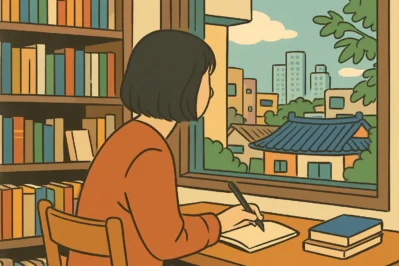Hello! Welcome to [Maeil Hangeul], your daily dose of Korean language and culture to level up your skills!
Have you ever felt the urge to capture your thoughts, feelings, or observations about the world in a more artistic way? Today, we’re diving into a topic that’s perfect for the advanced learner with a creative soul: how to conceptualize your very own poetry chapbook (시집). This isn’t just about writing poems; it’s about weaving them together into a single, powerful narrative.
Lately in Korea, especially in artsy neighborhoods like Yeonnam-dong and Haebangchon, there’s a huge boom in independent publishing (독립출판) and small, curated bookstores (독립서점). Young creators are bypassing traditional publishers to share their unique voices directly with readers. This means poetry is more alive and personal than ever! Learning how to talk about your creative concepts will not only refine your Korean but also connect you to the vibrant heart of contemporary Korean literature. Let’s get started!
Core Expressions for Your Creative Blueprint
Here are some essential, high-level terms you’ll need to articulate your poetic vision like a pro.
1. 기획 의도 (gihoek uido)
* Pronunciation: [gi-hwek ui-do]
* English Meaning: The core concept; planning intention; mission statement.
* Detailed Explanation: This is a crucial term used in any creative or business planning session in Korea. It’s more profound than just an ‘idea’ (아이디어). 기획 의도 refers to the fundamental purpose and direction of your project. Why are you making this chapbook? What central message or feeling do you want to convey? It’s your project’s soul.
2. 아우르다 (a-ureuda)
* Pronunciation: [a-u-reu-da]
* English Meaning: To encompass; to bring together; to integrate.
* Detailed Explanation: This verb is beautiful and nuanced. It means to gather disparate elements into a cohesive, harmonious whole. When planning your chapbook, you’ll use 아우르다 to explain how your individual poems, with their different subjects, will all come together under a single theme. For example, “이 시집은 기쁨과 슬픔의 감정을 아우르는 작품입니다.” (This collection is a work that encompasses the emotions of joy and sorrow.)
3. 결 (gyeol)
* Pronunciation: [gyeol]
* English Meaning: Texture; grain (like in wood); tone; style.
* Detailed Explanation: This is a wonderfully versatile and sophisticated noun. Literally meaning ‘grain’ or ‘texture,’ in a literary context, 결 refers to the overall tone, mood, or stylistic texture of a work. Is your poetry raw and gritty (거친 결)? Or is it soft and lyrical (부드러운 결)? Using this word shows a deep, almost tactile understanding of artistic expression.
4. 정체성 (jeongcheseong)
* Pronunciation: [jeong-che-seong]
* English Meaning: Identity.
* Detailed Explanation: A universal theme in art, 정체성 is a cornerstone of modern Korean poetry. Many poets explore questions of personal, cultural, or social identity. When discussing your chapbook’s concept, you might explain that it’s an exploration of your own identity as a foreigner living in Korea, or a meditation on the fluid nature of modern identity.
Example Dialogue: Brainstorming at an Indie Bookstore
(Two friends, Minjun and Chloe, are browsing at an independent bookstore in Seoul.)
A (Chloe): 와, 여기 독립출판물 정말 많다. 나도 나만의 시집을 한번 만들어보고 싶어져.
(Wa, yeogi dongnip-chulpanmul jeongmal manta. Nado namanui sijibeul hanbeon mandeureobogo sipeojyeo.)
Wow, there are so many indie publications here. It makes me want to create my own poetry chapbook.
B (Minjun): 좋은 생각인데! 클로이 시집의 기획 의도는 뭘로 할 거야?
(Joeun saenggaginde! Chloe sijibui gihoek uidoneun mwollo hal geoya?)
That’s a great idea! What would be the core concept for your chapbook?
A (Chloe): 음… 서울에서 보낸 사계절의 단상들을 아우르는 작품을 만들고 싶어. 도시의 차가움과 따뜻함이 공존하는, 그런 독특한 결을 표현하는 거지.
(Eum… Seoureseo bonaen sagyejeorui dansangdeureul a-ureuneun jakpumeul mandeulgo sipeo. Dosiui chagaumgwa ttatteuthami gongjonhaneun, geureon dokteukan gyeoleul pyohyeonhaneun geoji.)
Hmm… I want to create a work that encompasses my fragmented thoughts on the four seasons I’ve spent in Seoul. To express that unique texture where the city’s coldness and warmth coexist.
B (Minjun): 와, 멋지다. 이방인이자 도시인으로서의 정체성을 탐구하는 시집이 되겠네. 벌써 기대된다.
(Wa, meotjida. ibanginija dosiin으로서ui jeongcheseongeul tamguhaneun sijibi doegetne. Beolsseo gidaedwenda.)
Wow, that’s brilliant. It’ll be a collection that explores your identity as both a foreigner and a city-dweller. I’m already looking forward to it.
Culture Tip: The Rise of 독립서점 (Independent Bookstores)
The dialogue above is set in a 독립서점 (dongnip seojeom) for a reason! These aren’t your typical large-chain bookstores. They are small, intimate spaces curated by owners with a specific taste. Places like Storage Book and Film (스토리지북앤필름) or Goyo Bookshop (고요서점) are cultural hubs where you can find unique poetry collections, zines, and photo books you won’t see anywhere else.
Pro Tip: When you visit these stores, you’re not just shopping; you’re experiencing a subculture. Many young Koreans see writing and self-publishing poetry not as an elite academic pursuit, but as a trendy and authentic form of self-expression, much like posting on a personal blog or Instagram. Mentioning that you got your inspiration from a specific dongnip seojeom will instantly make you sound like you have your finger on the pulse of Seoul’s creative scene.
Let’s Wrap It Up & Practice!
Today, we learned four key terms essential for discussing a creative project in Korean:
* 기획 의도 (gihoek uido): The core concept or rationale.
* 아우르다 (a-ureuda): To encompass or integrate.
* 결 (gyeol): The stylistic tone or texture.
* 정체성 (jeongcheseong): Identity.
Now it’s your turn to be the poet!
Practice Challenge:
Imagine you are creating your own poetry chapbook. Using at least two of the words we learned today, write one or two sentences in Korean describing your concept. What is your 기획 의도? What kind of 결 will your work have?
Leave your poetic concepts in the comments below! We can’t wait to read your brilliant ideas.






